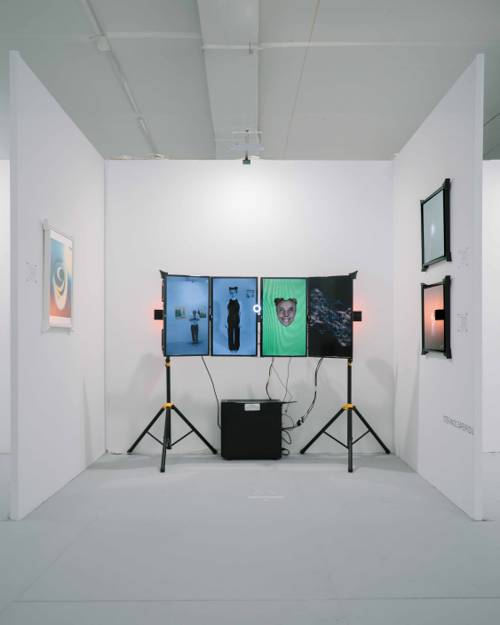
FAQ About The Evolution of Interactive Art Installations

What are interactive art installations?
Interactive art installations are artworks designed to engage viewers in a participatory manner. Unlike traditional art forms that typically involve passive observation, interactive installations invite users to become part of the artwork through physical interaction, digital interfaces, or immersive environments. This interaction can include moving around the piece, manipulating elements, or using technology to alter or engage with the art.

How do interactive art installations differ from traditional art?
Interactive art installations differ from traditional art in several ways. Traditional art, such as paintings or sculptures, is usually observed passively from a distance without engaging directly with the artwork. In contrast, interactive art installations require the audience's participation to complete the artwork, often using technology, movement, or other sensory experiences to create a dynamic and evolving experience.

What role does technology play in interactive art installations?
Technology plays a crucial role in many interactive art installations by enabling new forms of interaction and engagement. Artists use digital tools, sensors, virtual reality, and video to create responsive environments that change and adapt as participants interact with them. This technological integration allows for more intricate and innovative ways for viewers to interact with the art, often incorporating real-time feedback and customization.

Can you give an example of a famous interactive art installation?
One famous interactive art installation is "The Weather Project" by Olafur Eliasson. Installed at the Tate Modern in London, it featured a huge, glowing sun and mirrors on the ceiling, which allowed visitors to manipulate light and shadow with their bodies. This installation invited people to lie on the floor and become immersed in the atmospheric setting, engaging with the piece both physically and emotionally.

When did interactive art installations begin to emerge?
Interactive art installations began to emerge in the 1960s with the rise of installation art and happenings. Artists started exploring ways to involve the audience more directly in the art-making process, often blurring the lines between the artwork and the viewer. The development of technology in the late 20th century further propelled the growth of interactive art, allowing artists to create more complex and engaging installations.

Why are interactive art installations considered an important development in art?
Interactive art installations are considered an important development in art because they shift the role of the audience from passive observers to active participants, which can enhance engagement and personal connection with the artwork. This evolution challenges traditional notions of art and transforms the viewer's experience, often making it more memorable and impactful by involving multiple senses and personal interaction.

How have interactive art installations impacted audience engagement?
Interactive art installations have significantly impacted audience engagement by inviting viewers to become part of the art itself. This participatory nature creates a more immersive and personalized experience, which can foster deeper emotional connections and understanding. By actively engaging with the artwork, audiences often reflect more on its meaning and their role within it, offering a transformative experience compared to passive observation.

What are some common elements featured in interactive art installations?
Common elements in interactive art installations often include technology such as sensors, cameras, and software that allow for real-time interaction. Physical components like touch-sensitive surfaces, moveable parts, or spaces designed for walking and exploring are also frequent. Additionally, sound, light, and environmental changes are used to create a sensory experience that encourages audience engagement.

How have advancements in digital technology influenced interactive art?
Advancements in digital technology have greatly influenced interactive art by expanding the possibilities for engagement and participation. Technologies such as augmented reality, virtual reality, and artificial intelligence enable artists to create more immersive and complex experiences. These technologies allow for real-time interaction, personalized experiences, and dynamic environments that can change based on user input, revolutionizing how art is experienced and interpreted.

What is the typical goal of an interactive art installation?
The typical goal of an interactive art installation is to create an engaging, immersive experience that invites the audience to participate actively. These installations aim to challenge traditional viewer roles, evoke emotional or intellectual responses, and offer new perspectives on the relationship between art and its audience. By including the viewer in the creation or experience of the art, the goal is often to explore ideas such as interactivity, community, and connectivity.

Who are some renowned artists known for interactive art installations?
Renowned artists known for their contributions to interactive art installations include Yayoi Kusama, Olafur Eliasson, Rafael Lozano-Hemmer, and TeamLab. These artists have created various installations that engage the audience through interactivity, technology, and immersive environments. Their work often explores themes of perception, nature, and human interaction, and they push the boundaries of how art is experienced and interpreted.

Are interactive art installations always digital?
No, interactive art installations are not always digital. While many incorporate digital technology for interaction, others use analog methods or natural phenomena to engage the audience. For example, some installations might involve physical movement, sound, or simple mechanical systems that do not necessarily rely on digital components. The core aspect is audience interaction, which can be facilitated through various means, both digital and analog.

What challenges do artists face when creating interactive installations?
Artists face several challenges when creating interactive installations, including technical difficulties in implementing responsive systems and ensuring that the installation works as intended with various interactions. They also must consider participant behavior, which can be unpredictable, and design the installation robustly to accommodate different levels of engagement. Additionally, logistical concerns, such as space requirements, safety, and accessibility, must be addressed to create a successful and inclusive experience.

In what ways can interactive art installations enhance learning or education?
Interactive art installations can enhance learning or education by providing immersive and engaging experiences that facilitate exploration and discovery. By making learning more active and participatory, these installations can help convey complex ideas or themes in a memorable way. They encourage problem-solving, critical thinking, and creativity, making them valuable tools in educational settings, museums, and even public spaces dedicated to learning.

How do museums and galleries incorporate interactive art installations?
Museums and galleries incorporate interactive art installations by dedicating space to accommodate these works, often in specially designed rooms that allow for full participation. They may create exhibitions or events specifically centered around interactivity to attract diverse audiences. These institutions also use technology or guided experiences to facilitate interaction, aiming to enhance visitor engagement and provide unique and memorable visits.

Do interactive art installations always require physical interaction?
Interactive art installations do not always require physical interaction. Some installations allow for other forms of participation, such as vocal input, motion detection, or interaction through mobile apps or digital interfaces. While physical interaction is a common method, the essence of interactive art lies in the engagement of viewers with the work, which can be achieved through various forms that do not necessarily involve physical contact.

How do interactive installations reflect changes in society and culture?
Interactive installations reflect changes in society and culture by addressing contemporary themes, such as technology's impact on humanity, environmental concerns, and the nature of communication and community. They often highlight the evolving dynamics between individuals and their surroundings, encouraging audiences to reflect on their place within these contexts. As society becomes more interconnected and digitally driven, interactive art serves as a medium to explore and comment on these transformations.

What are the environmental considerations for creating interactive art installations?
When creating interactive art installations, environmental considerations include the materials used, energy consumption, and impact on the surrounding space. Artists and curators might prioritize sustainable materials and eco-friendly technologies to reduce the installation's environmental footprint. Additionally, temporary installations that aim to minimize physical changes to their environment are often designed to be easily dismantled and recycled.

How are the aesthetics of interactive art installations different from traditional art?
The aesthetics of interactive art installations often focus on dynamism and sensory engagement, contrasting with the static nature of traditional art. These installations prioritize user experience and often feature minimalist or abstract designs that facilitate interaction. The visually appealing integration of technology, light, and sound contributes to a multi-sensory aesthetic that changes based on viewer participation, highlighting the transient and adaptive nature of interactive art.

Can interactive art installations exist outside physical spaces?
Yes, interactive art installations can exist outside physical spaces by utilizing virtual environments or augmented reality. Such installations can be accessed online or through digital devices, allowing for remote participation. These virtual experiences extend the boundaries of traditional art spaces, offering broader access and the ability to engage with art from anywhere in the world, thus redefining the concept of an installation.
